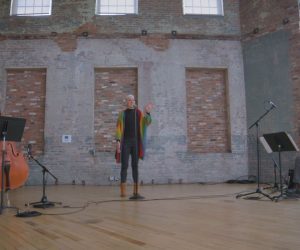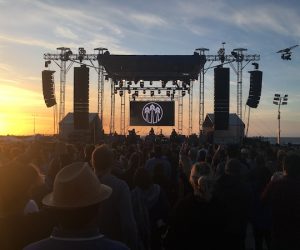
Production Abduction
This is what can happen when the music and the medium take over…
Text: James Wilkinson
Sometimes you wonder if you’re an idiot, and other times it seems by official decree that you’re dumb as they come. I (being a Libran) am always weighing up the two alternatives with much consideration, but after completing a recent project the votes are in and it’s a clear majority. I am a Wally.
You can try to be smart: plan, research, discuss and make decisions based on experience, but often it’s not until later that you realise just how wrong and misguided you were. I recently recorded an album where each of these so-called considerations combined to build a ‘thing’ that grew and grew until eventually it was out of control. Sometimes the sum of the parts fit together to make a creature that behaves beyond the force of your will. “It’s alive!”
In my teens the humble four-track portastudio was a sophisticated device and it took my remedial brain some time to comprehend how four tracks of audio fitted on to a compact cassette. To the naïve soul of a genuine adolescent, unquantifiable joy was possible by committing your genius – in the form of verbal expletives – to tape, ejecting the cassette, turning it over and then listening to what you’d just recorded backwards. Now that was a revelation.
Dropping in and out, bouncing down and mixing using the primitive EQ amongst a sea of hissing tape noise was (and still is) a complicated, focused and high-risk operation. Decisions were permanent – there was no turning back. No undo function. Many an urban classic was ruined when, in a conflicted synaptic understanding of the technology and what was happening musically, all or part was erased by that final overdub. And sometimes the machine literally chewed the tape. Recording on a four-track recorder was serious stuff and sometimes it meant the life or death of your music!
NO GOING BACK
By comparison, today’s digital audio workstations offer vastly more tracks, a whole range of options with which to edit, manipulate and automate your material, and in doing so give a much broader framework for the creation of recorded music. But is all this liberty a good thing?
Let’s get one thing abundantly clear: I’m not here to propose that ‘young people of today have too many audio recording choices and they should learn to cut their teeth recording local church sermons on a Fisher Price cassette recorder with one hand tied behind their back’. Not at all. Rather, I’d like to simply relate a recent experience of what can happen when a recording starts to grow beyond your capacity to manage it – let alone mix it – in the hope that others might learn from my mistakes.
TO INFINITY & BEYOND
For the obsessive type, driven to attain his or her own unique standard of achievement, the world of digital recording, with its ability to infinitely finesse a performance or sound, is a powerful and sometimes dangerous proposition. Around the planet, as you read these words, there are solitary types hunched over laptops, scrutinising, dreaming and constructing elaborate works of art that no-one will ever hear, engulfed in a process that enslaves them to work and rework their idea forever and ever and ever. I for one support these individuals in their quest but there’s a juncture where the technology of composition becomes the platform for addiction, and anything addictive is potentially unlawful!
A recent experience of mine illustrates just how easy it can be for an engineer or musician to get tangled in the digital recording process – what follows here is a reflection on a recent project where I was employed to record, edit and mix an album of 13 songs.

NO-LIMIT ‘60s
The artist is a friend of many years. He studied classical music in Australia and overseas, releasing a double CD of his work a few years ago – one written for contemporary classical ensemble and the other a piano concerto – which I helped to edit and mix. The current album is a collection of original pop tunes, some of which were written a decade ago, inspired at times by The Beach Boys, The Beatles, Stereolab and others. The music is positive, elaborate and densely composed with many additional instrumental and vocal parts built around a six-piece band. His recordings (although acoustic in nature) are subject to a lot of re-interpretation by computer. The brief was to engineer the recording at a studio after which he’d take it home to audition and edit the takes, followed by more studio overdubs and then mixing. Simple!
As the musical inspiration was albums mostly recorded in the ’60s we went for an approach that drew upon these recordings, choosing a studio that, in addition to being able to track the band live, had recording equipment similar to the era concerned. Plans to use a multitrack tape machine were swiftly ditched when it broke down, and the entire album was recorded instead directly to ProTools HD. Being able to employ a large session band (like The Wrecking Crew as The Beach Boys did) wasn’t an option financially, so all additional parts, except the string arrangements, were done as separate overdubs.
For overdubs the approach was to record each instrument with both near and ambient microphones, and use the natural acoustic to blend the ensemble by controlling how near or far the instrument sounded in the soundstage. My intention was to fabricate an ensemble and its surrounds using only my genius and ProTools HD, the only problem being… I am no genius.
To counteract the limitations of 64 simultaneous tracks in ProTools 8 LE (which the composer used at home), each multitrack recording – from the original tracking to overdubs – was done in a separate session. A stereo mix of the completed parts and a click track were used as the basis for recording all the additional overdubs, and to keep things clearly defined, three ‘groups’ were established to separate the different elements: Band, Orchestra and Vocals. Dividing the musical elements into these categories made it easier to work on; it also meant that there were three overdub sessions associated with each of the 13 songs, or in all, nearly 40 independent sessions. When it came to mixing, these three overdub sessions would then be merged into one on a ProTools HD system.
GROUP SESSIONS
The first tracking session involved five days recording with the musicians playing together in the studio. The band consisted of drum kit, electric bass, two electric guitars, two keyboards, vibraphone and guide vocals. After recording the ensemble and some basic overdubs, roughly 36 tracks for each song had been recorded in ProTools, or 468 separate audio tracks for the album.
The second session was all about vocals. The songs had been auditioned and edited into shape by this point, to which we recorded lead vocals, vocal overdubs and a choir of five singers. The largest total of tracks for the vocal session on one song was 32. Now we were sitting at around 780 separate audio tracks for the album… and climbing. (I would have left the vocals till last, given the complexity of the music, but the main female vocalist was leaving the band so we had no choice.)
Session 3 involved overdubbing guitar, keyboards, piano and percussion, using at least two tracks for each individual part. Total in all: around 24 tracks per song, bumping us up to four figures – over 1000 tracks for the album.
Session 4 was recorded over two days and it was big – with clarinets, saxophones, flutes, piano, percussion, vibraphone, trombones and trumpets all tracked separately. A five-piece string ensemble sounded fantastic using a Blumlein pair of ribbon microphones, but again, no less than two mics were deployed and recorded for each instrument, with the total track count for the larger songs for this session alone comprising over 60 tracks. Is anyone adding all this up?
The fifth and final session was arranged to re-record some bass parts with the band’s new bass player, backing vocals with the band’s new keyboard and vocalist, and other sundry instruments. On average about 16 tracks were added to each song during this session, and in total the album now consisted of about 1500 individual tracks.
I know it might sound a little weird to be adding the track counts of each song together to create one large number like this, but that’s just the point. I wasn’t, and that was the problem. I was aware that the sessions were getting large but I was also determined to see my original concept carried through regardless, rather than change tack mid-course away from what was an ever-increasing track count and workload.
LOSING TRACK
In total all the larger songs were pushing 170 tracks, which although well within the 200-odd track limit of a ProTools HD2 system, were certain to generate a major time crunch given there was only one person to prep them into shape – me. If, for example (as was pointed out later during the mixing sessions) only one minute was spent on each track – and let’s face it, who only spends one minute on a track – just editing and auditioning all the tracks on one song would take about three hours to cover every element in the mix. Add to this, fades, edits, beat correction, re-pitching and anything else that might be an issue, multiply that by the album’s 13 tracks and it was going to take a minimum of three days just to review the material we’d recorded, and in reality, more like a week! We set aside two weeks to compile and pre-mix the sessions, but even this turned out to be a gross underestimate. At the end of 12 long days I’d only addressed the fundamentals, i.e.: is everything in order and ready to go? And what hasn’t been conveyed thus far makes these technical issues at hand even more complicated.
HOUSE OF CARDS
In making an album, the prospect of success or failure most often hangs in fragile balance. From experience the themes of money, creativity and personal relationships are central to any project’s success. If one or all of these elements are missing it’s not uncommon for everything to be compromised or, at worst, laid waste. This project took over two years to complete, and two years is a long time to keep up the momentum of a record, as a lot of unexpected things happen in that time.
When it came to do the majority of the editing and mixing, not surprisingly a lot of the sessions had become ‘creative works in progress’. The composer had re-worked some of the music into sound collages using and effecting material from different sessions, and as a result there were now two new songs on the album (making a total of 15). There had also been a lot of doubling of parts using different takes (which pushed one song to 275 tracks!) and various versions made of the same session with less than explicit names. Files were missing or spread across four different hard drives and Audiosuite processing had overwritten the original sessions’ regions. Politely put, it was a total mess.
For better or worse, the logic that underwrites computers is not always conducive to the needs of the creative artist, and simple things – like what you name your session – can sometimes be the difference between mistakenly deleting or keeping your work; every bit as dangerous as those old four-track cassettes. But when you’re in the thick of a creative mood, file management is not always at the forefront of one’s creative mind.
Tape machines have time and track limits and musicians can only play for so long, but theoretically you could press record on your computer and, provided there was the disc space, keep it rolling until the end of time (except that there would of course be no-one left to do the overdubs). Tape degrades. Musicians die. Meanwhile a recording made on a computer will exist in its pristine state – in theory – forever. So how do you say: “stop, it’s finished!” when the digital medium perpetually promotes your unbridled desire to keep recording, improving upon and revising the last improvement of an improvement?
With a ProTools system at home, my friend could audition, edit and add to any of the album’s parts throughout the project’s development, and rightly so – it’s his music! But, from my end, as the engineer, what this added was a great amount of uncertainty as the process became completely fluid – what you’d just completed could well come back with new parts to include the next day. Add to this the analogue domain of large format mixing consoles, dynamic processing and effects – i.e., mixing in a room of non-recallable devices – and the romanticism and ‘amazing sound’ of a classic analogue studio quickly becomes irrelevant in the face of just dealing with the immense amount of work at hand.
In addition to the unforseen issues, my desire to recreate an ensemble using close and ambient mics was also problematic and short sighted. Not because of how it was recorded or some other technical issue – the overriding factor was that there simply wasn’t enough time to mix! Instead, other elements needed time spent more urgently, and a similar result could have been achieved by summing the ensemble parts as they were recorded, saving time on mixing later.
MIX MAYHEM
Having lots of stereo recordings was difficult to include in the mix too. With so many tracks and layers of sound in the arrangements, finding a place to put something between the two speakers was surprisingly challenging. It had a lot to do with the arrangements, but how many glorious full-range stereo recreations of a piano can you have when there are three of them all playing together? And if they’re also competing with another five stereo keyboards, what then? Next time I’ll be recording in mono and mixing in stereo.
In retrospect I’d mix the album completely on a computer and forget about mixing in the analogue domain given what I now know of my friend’s process – although in this case a four-track portastudio would have imposed appropriate limitations! It suits him to be able to redress anything, anytime and continue to review until he’s satisfied. For a while there I thought the process and its deadlines would limit his urges to keep finessing the music, but like any true creative, he just kept on keeping on making the record he wanted to make, and who am I to tell him how, for the true success or failure of the work lies only with those whose music it is. The rest is incidental.
The moral of this tale is not so much about song arrangement and artistic limitation, it’s really about simply understanding the process and learning from your mistakes. Mine were several and varied, but possibly the greatest single mistake I made was to let the channel count climb rapidly without any real understanding of how much work it would present later. I also misread the appropriate application of technology given the needs of the artist, and that digital multi-tracking’s many choices would provide us options to the point of paralysis. Defining sounds during the tracking session and printing them to a minimum of tracks might sound like an old fashioned and limiting concept to some – it did to me at the time – but ironically it’s turned out to be more relevant now than ever before!
















RESPONSES